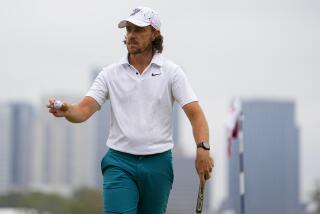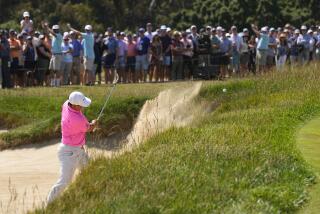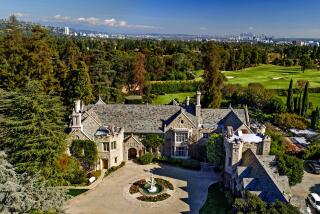HE’S STILL CALLED : MR. 59 : Al Geiberger’s Feat in Golf May Never Be Surpassed
- Share via
SAN DIEGO — There was a time when Babe Ruth’s record of 60 home runs in a season was considered unbreakable.
Roger Maris disproved that, albeit with an asterisk, by hitting 61 home runs in 1961. He did it in a 162-game schedule, eight games more than the schedule played in major league baseball when Ruth hit 60 in 1927.
After that, Joe DiMaggio’s 56-game hitting streak in 1941 seemed the closest to being unreachable, and perhaps it is. Nobody has topped it in 46 seasons.
Then Bob Beamon came along with an astonishing long jump of 29 feet 2 1/2 inches in the Olympic Games at Mexico City in 1968. That record still stands.
But although a slim possibility exists that DiMaggio, Beamon or both will be bumped out of the record book someday, one record-holder is probably the safest of all.
In 1977, golfer Al Geiberger shot an 18-hole round of 59 on the second day of the Danny Thomas Memphis Open. His feat broke a PGA Tour record that had stood since Sam Snead shot a 60 in 1957, and nobody has done better than 61 since. Geiberger himself shot a 62 last year.
It would be stretching to predict that Geiberger’s record will never be broken, but mere mathematics makes that unlikely.
With athletes growing bigger, stronger and faster every year, someone in the foreseeable future conceivably could hit safely in 60 straight games or long jump 30 feet.
In golf, however, scores can be trimmed only to a certain point. As Geiberger puts it, there is “only so much room” for improvement in a given round. His round of 59 was just about as close to perfect as a round can get.
Geiberger, who lives in Palm Desert, talked about his historic accomplishment as he looked ahead to the $500,000 MONY Tournament of Champions at La Costa Thursday through Sunday. He will compete in the Legends portion of the tournament, having won 3 of 10 senior tournaments after turning 50 last Sept. 1.
“The amazing thing about my 59 is that I actually had room to shoot a 58,” he said. “If I had birdied the 17th hole, the longest on the course, I could have done it. I hit a big drive, and after my third shot, I was a 20-foot putt away. I left it just six or eight inches short.
“But aside from that, I can’t see anyplace in that round where I could have done any better than I did. When you shoot 13 under par, you don’t have much time for pars. Eventually you run out of holes. As it was, I was beating the odds.”
Ever since that magical round, Geiberger has been known on the golf circuit as Mr. 59. His peers address him that way, and fans shout, “Come on, Mr. 59,” when they cheer for him in a tournament. He even uses the name of a mythical business, “Mr. 59 Enterprises,” on his bank checks and telephone answering machine.
The 59 idea boomed to the point where in 1985, the Beaver Creek Resort Course in Vail, Colo., which Geiberger represents, sponsored a Mr. 59 tournament. Anyone shooting 59 or better would have won $1 million.
“Fortunately, no one came close,” Geiberger said. “The best I could do was 69.”
Geiberger can’t begin to measure how much his record round has meant to his career.
“The 59 has been my little claim to fame,” he said. “It has given me my special niche. It’s hard to put a figure on the positive effect it has had, but it has done a lot for me.
“This has been especially true in the last five years. When I shot the 59, people paid little attention to it. But trivia got big about five years ago, and that has put my name in the limelight. People today are very trivia-minded, and my 59 has become a very popular sports question.
“Also, golfers talk to other golfers, and their respect for me has grown. My compatriots will say, ‘That has to be the greatest round ever shot.’ It means a lot to have the respect of your fellow competitors.
“Once my identity was locked in, it helped me get invited to play in a lot of corporate outings and make many other personal appearances. Sometimes life is like that. You can’t always predict the effect of something as soon as it happens.”
Geiberger’s dream round consisted of 11 birdies, an eagle and 6 pars. He played the first nine in 30 and the second in 29, needing just 23 putts along the way. And lest anyone think he was on an easy course, the Colonial Country Club layout in Memphis is one of the longest on the tour--7,249 yards.
“The funny thing about it is that if I hadn’t made a 10-foot putt on the last hole, we wouldn’t be talking about it today,” he said. “I hit every fairway and every green, and holed every putt except that one on 17.
“I wasn’t getting a lot of two-foot putts, either. I did have one of about a foot, but otherwise the shortest was eight feet. I had two of those, and one 10-footer. The rest were from way out there--13, 14, 15, 20 feet, even one from 50 feet. And I holed out a wedge from 30 yards away for an eagle on No. 10, a par-5.”
Asked to pinpoint his shot of the day, Geiberger said, “The wedge shot that went in was a big one, but I think the 50-footer I made on the first hole was even bigger. That’s what got me started.
“As it was, though, I had only one other birdie on the first five holes. That was on No. 3. I was only two under par after five holes, and I wasn’t even thinking about a hot round.
“Then I suddenly went on a rampage. I shot birdie, birdie, birdie, birdie, eagle, birdie, birdie. That put me eight under for a stretch of seven holes in the middle of the round, and 10 under for the day.”
Geiberger said that not getting hot until he had played five holes was one of the keys to his success.
“If I had started with five birdies, it would have been hard to keep going,” he said. “Most of golf is a big mental battle, and when you birdie something like the first eight holes, it’s hard to keep it up. You can’t concentrate like you did at first. You’re on another frequency, another wave length.
“The way I did it wasn’t easy, obviously, but I had a better chance to keep going because I didn’t get my head in the clouds until the back nine. When I realized I was so many under par, I thought, ‘What have I gotten myself into?’ Then I started talking to myself, and that took some of the pressure off me.”
Geiberger thought back to his college days at USC, from which he graduated in 1959 with a degree in business. His USC coach, Stan Wood, always wanted him to be more aggressive. Wood is now in public relations and golf tournament management, and serves as media director of the Tournament of Champions.
“I was basically a conservative player, and I still am,” Geiberger said. “But right there, as I walked from the 14th green to the 15th tee, I remembered Stan’s advice and made up my mind to let ‘er fly. I was determined to go for it.
“When I continued to do so well, the gallery started yelling, ‘59, 59!’ Once the word got out, people drifted over from other spots on the golf course. The gallery kept growing to the point where I think everybody on the course was watching me. It was unbelievable.
“One thing that helped was the weather. It was so hot that I wasn’t thinking about my score as much as I was about survival. It was 103 or 104, and I was afraid I was going to collapse.
“All in all, it was a combination of things. The way I was hitting the ball, my putting, the hot weather, and the fact that the way the round developed kept me from getting too carried away.”
Geiberger also thanks his playing partners, Jerry McGee and a fellow USC alumnus, Dave Stockton.
“Dave kept me loose when the pressure started building,” Geiberger said. “I think I usually play better when I’m paired with him because we always get along so well.
“And Jerry did a wonderful thing on the last hole. After Dave putted for his 76, Jerry had a tough downhill putt, and he told me to go ahead and putt first. I had a 10-footer that I had to have for the 59, and it hit dead in the back of the cup.
“The crowd went wild, and there was no way they would quiet down for Jerry to putt, but he finally did, and it went in. I was thankful for that.”
Stockton finished with a 76, and said after the round: “There I was, playing poorly and wanting to hide, and because of Al, the whole world was watching me.”
It could be assumed that the story of Geiberger’s 59 ended with a runaway victory in the tournament, but that didn’t happen. Yes, he won, but only after squandering his big early lead.
“After I shot the 59, there was a lot of pressure on me to do it again,” he said. “Actually, all I was thinking about was that I just couldn’t blow the tournament after shooting a 59. That would have been very embarrassing.
“I had a six-shot lead after my big second round, and a three-shot lead after the third round. By the ninth hole of the last round, I had lost my lead. I was one stroke behind Gary Player.
“At that point, though, it seemed like the monkey was off my back. Once I had lost my lead, shooting a certain score was no longer my responsibility. With the pressure off, I came back and played the last nine in 32, and won by three strokes.”
Ten years later, Geiberger shot his 62, in the final round of the Las Vegas senior tournament last October. And as he recalls that round today, he is convinced that it had the potential to be another 59.
“I really passed up some chances for birdies that day,” he said. “There was room to trim off a few strokes. I might have had birdies on a couple of par-5s, and one or two other holes. I lipped out on three of them.
“The trouble was, it was the last day, and I just wanted to win the tournament. I had played four weeks in a row, and I was exhausted.”
Chi Chi Rodriguez, playing with Geiberger that day, said he thought Geiberger could have shot as low as 58 with all the right breaks.
Purses on the senior tour are generally lower than those on the regular tour, yet Geiberger earned a career-high $265,000 in his brief introduction to senior competition last fall. The $135,000 he got for his first senior victory, in the Vantage Cup in Clemmons, N.C., was the largest prize of his career. Later, he won at Hilton Head, S.C., then Las Vegas.
Although Geiberger made $1,256,000 in 28 seasons on the regular tour, he topped $100,000 only twice, with $176,000 in 1975 and $195,000 in 1976. He won 11 tournaments, including the PGA in 1966 and the Tournament of Champions and Tournament Players Championship in 1975, but purses were more modest in those days.
“I think I got $25,000 for winning the PGA,” he said. “Inflation hadn’t set in yet.”
Geiberger’s PGA victory was followed by an eight-year drought in which the most he earned in any year was $65,000. He finally broke through by winning the Sahara Invitational in Las Vegas in 1974.
“When that happens, you have to battle doubts in your own mind,” he said. “I had won tournaments in ‘62, ‘63, ’65 and ‘66, and suddenly I lost the feeling of winning.”
Once the Sahara victory had restored his confidence, Geiberger won five more tournaments in the next three years, climaxing his run with his classic 59 in 1977. He also won the Colonial Invitational in Fort Worth in 1979, and that turned out to be his last victory on the regular tour.
Not long afterward, Geiberger encountered the most serious setback of his life. His health deteriorated to the point where he thought he would never set foot on a golf course again. In July, 1980, he underwent emergency surgery for removal of his colon.
“I had had intestinal problems off and on for a long time,” he said. “In ‘78, I had an operation to remove massive polyps from my colon. They took out a 3-inch section of my colon.
“I recovered from that, but in ’80 I had a lot more problems. The polyps were growing back in a big mass. They were like a bunch of grapes, the size of a baseball. They created a blockage, and the doctors said my track record was so bad that they had no choice but to take out my whole colon. The polyps could have developed into cancer.
“The procedure was called an ileostomy, which is like a colostomy. It created a passage from the small intestine to the abdominal wall. After that, I had to wear a plastic bag, or an appliance, as I call it.”
Understandably, Geiberger’s morale was near zero at that point.
“When I found out about the appliance, I was very depressed,” he said. “It sounded gruesome, really terrible. I figured there would not only be no more golf, but that it would be like the end of the world for me. I couldn’t imagine myself living with one of those things.”
Gradually, though, Geiberger’s spirits improved. One of the biggest factors in his psychological recovery was learning that Rolf Benirschke, then the kicker for the Chargers, had undergone the same operation and was playing again.
“I remember what a lift that gave me,” Geiberger said. “Rolf and I became good friends, and now we work for a company that makes the appliances. We endorse the product and speak to people who have had the same surgery. Each year, we select two people who have made the greatest comebacks.
“Another person who helped was Otto Graham (a member of the Pro Football Hall of Fame). He had had the operation, too. When he called me in the hospital, a nurse said, ‘The man says his name is Otto Graham.’ She didn’t know him from Adam, but the doctors were impressed.
“At that point, I was happy to be alive. Every day was golden and great. All of a sudden, a three-foot putt wasn’t that important. On top of that, I realized that I could lead a normal life.
“I’ve even had two children since then. Al Jr. was just born Jan. 2. Now I have five.”
When he reached his late 40s, Geiberger began planning for the senior tour.
“Most people hate the thought of turning 50,” he said. “I couldn’t wait. The other tour is so tough, so deep in talent, that if you lose a little bit of desire, which I did, they run over the top of you. Once you’ve lost it, you can’t get it back.
“With the senior tour to look forward to, I geared everything for a new beginning. I’m just grateful for the second chance.”
More to Read
Go beyond the scoreboard
Get the latest on L.A.'s teams in the daily Sports Report newsletter.
You may occasionally receive promotional content from the Los Angeles Times.










